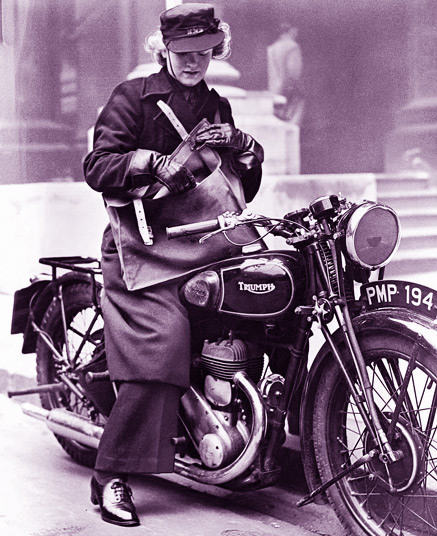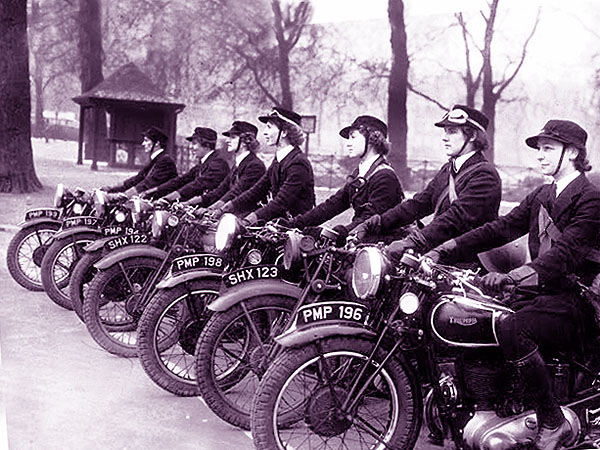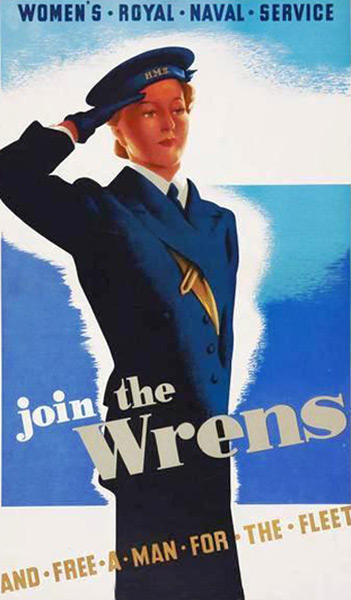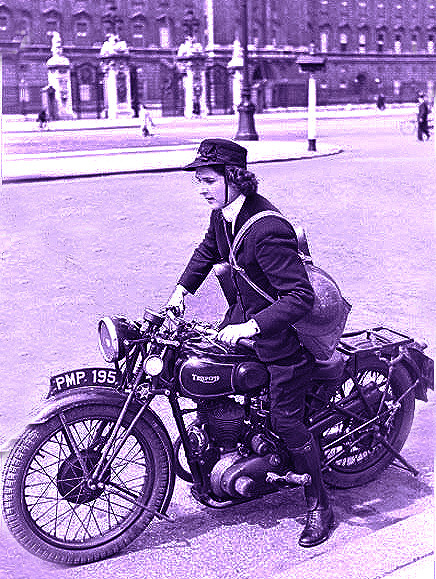|
WW2 Female
motorcycle messengers - Compiled by Chas Moody
 |
Some of the many vehicle
identification enquiries received by the SVVS can be answered from
personal knowledge by members of our team, but most require a degree of
research and investigation.
Often, those in the latter category unearth interesting information which
cannot be included within the limited space of the small box on the Help
Pages.
Some enquiries during the investigation phase develop a life of
their own and reveal fascinating historical information which warrants
including and illustrating in a full length article.
One such enquiry was received in late March 2021 from our regular
correspondent Mark Dawber of New Zealand who has a nose for interesting
unsolved mysteries.
He had found this picture of a smart female motorcycle
messenger, and asked the following question:-
"Hi Bozi, I hope your number plate info is better than mine.
The attached photo was spotted on facebook.
The bike is a just-pre-WW2 Triumph 3SE and looks quite new there. The
plate, appears 1950s.
Maybe there is something missing in the plate info. The earlier MP plates,
up to KMP, were pre war. My Newall register does not seem to have a reference to a PMP
series.
MP seems London > Greater London. Despite what it says elsewhere, I cannot find any mention of any reg. with
any prefix before MP.
What am I missing? Guess the registration may have been reserved for say,
Navy?? The Lady seems to have a uniform with a 'HMS' on the hat?" |
|
Mark's query posed three questions:-
1) The date and area or authority of the
motorcycle registration number.
Our Tony Oakes advised on the first question and confirmed that PMP
registrations date from 1939 and were used by the War Department.
|
|
2) The model of Triumph motorcycle shown. |
|
The motorcycle is obviously of Triumph manufacture, c.1939, and has
a four stroke side-valve engine, but what model is Mark referring to? The 1939
Triumph 'home market' catalogue lists two side-valve models, the
600cc '6S Deluxe' and 350cc '3S Deluxe'. The machine pictured is the smaller
350cc model but is not to the specification of the 3S Deluxe shown below.
|
The 3S Deluxe machine was introduced in 1937, replacing the previous 3/1 model and
has a chromium plated petrol tank with black side panels and a tank top
instrument panel which carries an oil gauge, lighting switch, ammeter and
inspection lamp. The wheel rims are chrome plated and the primary chain case is
of polished cast aluminium.
|
Please Click
on the thumbnail photos to see larger
picture
|
The messenger's motorcycle has a more basic finish with a plain black petrol
tank, painted wheel rims and minimal chrome plating. This would make it the Export Edition of Triumph's catalogue where we find the 3SE
model, confirming Mark's initial identification. The '3' stands for 350cc, 'S'
for side-valve and 'E' for export (or possibly Economy?) Apparently this model
was produced in response to requests from the Australian and New Zealand markets
for a basic, robust utility motorcycle with no fancy equipment for use on the
unmade roads and farms in those countries. |
As well as it's mainly all-black finish, the 350cc 3SE is devoid of the tank
top instrument panel supplied on the Deluxe model.
This was one of the
'features of doubtful value' mentioned in the specification below.
The polished
aluminium primary chain case of the Deluxe model is replaced by a cheaper unit
of painted pressed steel. |
Please Click
on the thumbnail photos to see larger
picture
|
3) What is the uniform
the lady is wearing |
|
Answering the third question and confirming Mark's guess, the uniformed rider
is a member of the Women's Royal Navy Service (W.R.N.S.) - popularly and
officially known as the 'Wrens', hence the letters 'HMS' displayed on the
messenger's hat.
The Women's Royal Naval Service was the women's branch of the
Royal Navy. First formed in 1917 for the First World War, it was disbanded in
1919, then revived in 1939 at the beginning of the Second World War, remaining
active until integrated into the Royal Navy in 1993.
The first Wrens were
recruited in 1917 to perform tasks traditionally carried out by non-enlisted
women. Jobs like cooks, stewards and typists, etc. but it soon became necessary
to increase those roles to include jobs which previously had only been held by
men.
This included motorcycle despatch riders, whose primary role was to ferry
orders and messages between Royal Navy command centres, offices and bases when
telecommunications were limited and insecure.
Initially, only women with prior
motorcycle riding experience were selected. Popular recruiting grounds were
motorcycle racing circuits where female racers were recruited.
Here we see a Wren on her 350cc
Douglas motorcycle delivering a message to a Royal Navy rating.
|

|
Please Click
on the thumbnail photos to see larger
picture
|
When the Wrens were re-formed in 1939 at the beginning of the Second World
War, their roles were considerably expanded to include flying transport
aircraft, forming all-female anti-aircraft teams, being trained as welders and
carpenters, maintaining and repairing ships in naval bases. All able-bodied seamen were
needed in the Royal Navy, and the Wrens adopted the famous slogan "Join the
Wrens and Free a Man for the Fleet." |
Wrens were also employed
to do office work, learnt communications and signalling, weather
forecasting (meteorology), engineering, driving, mechanics and radar
operating. Once again, the Wrens were called upon to serve as despatch
riders. The Royal Navy wanted women despatch riders who could not only
ride motorcycles, but could also fully maintain their own machines. |
Please Click
on the thumbnail photos to see larger
picture
|
The
above picture shows a despatch rider opposite Buckingham Palace. The
pressed steel 'economy' primary chain cover of the Triumph 3SE is clearly
evident. |
Triumphs
were not the only make of machines used by the Wrens. Here, and below, we see two
despatch riders on their 350cc side-valve BSA C12 mounts. |
Please Click
on the thumbnail photos to see larger
picture
|

|
|
Before anyone jumps up shouting "That's not a BSA C12!", it must be
pointed out that the C12 name was reused after the war for an entirely different
250cc OHV model. The C12's shown here were a new 350cc model for 1940, fewer
than 400 of which were made and approximately 38 were taken by the Admiralty.
Most were requisitioned by the Army with only a small number ending up in
private hands, As a result, there are very few surviving examples of this quite
handsome machine. |
|

|
|
The probable reason for so few 350cc BSA C12 models being made is that the
BSA factory was flat out manufacturing thousands of their 500cc side-valve WM20
machines for Military use. The Triumph factory was also hard at work churning
out the military version of the 3S, designated 3SW. Just before the start of
WW2, the War Office contracted Triumph to supply 10,000 3SW models which were
Initially produced in Triumph Coventry factories (such as Priory Street) but the
factory was bombed by the Luftwaffe on the 14th November 1940, halting
manufacture. Production was then switched to Warwick before finally settling in
Meriden and the 3SW model was given a reprieve. The last 3SW model was built on
the 31st October 1941 when the new 350cc overhead-valve 3HW model was ready to
start production. The 3SW is pictured below and whilst its specification is
similar to the 3SE Export model, it can be seen that the primary chain case is
the cast aluminium type of the UK model, so obviously not of 'doubtful value' as
inferred by the Export Edition of the Triumph catalogue! Also visible is the
long, tubular 'field stand' which runs parallel to the upper rear frame stay
which was used on rough terrain where the rear stand was not suitable. |
 |
The question remaining is why the Wrens were using Export Model 350cc
Triumphs? It can only be assumed that these models, originally intended for
overseas markets, could not be exported due to Wartime conditions and the
Military 3SW model was contracted to the Army, so the 3SE's were available for
use on the home front.
Our messenger pictured at the beginning of this article
riding the 3SE registered PMP194 appears in the group line-up below in which
there are several PMP registered machines.
PMP196 in the foreground is a model
3s Deluxe, which shows that some Wrens were issued with the home market model
complete with chrome plated tank and switch panel and polished aluminium chain
case.
No wonder the rider looks pleased with herself! |
|

|
|
The Wren motorcycle despatch riders achieved a great deal of recognition
during World War 2, during which over 100 Wrens lost their lives serving their
country. Their work throughout the Battle of Britain was highly praised and they
became famous across the world as a shining example of the work carried out by
women during the War. |
This educational article is a compilation of
information from numerous sources. I would particularly like to thank the following
websites for some of the text and pictures used in this article:- Real Classic,
Motoress, Hot Car, Womenriders now.com, ManxNorton.com, Graces Guide,
Barnstormers.co.nz, Triumph Owners MCC, Vintage.es .
Chas Moody
Go to Recent Venues
Page
PICTURE GALLERY INDEX
|














